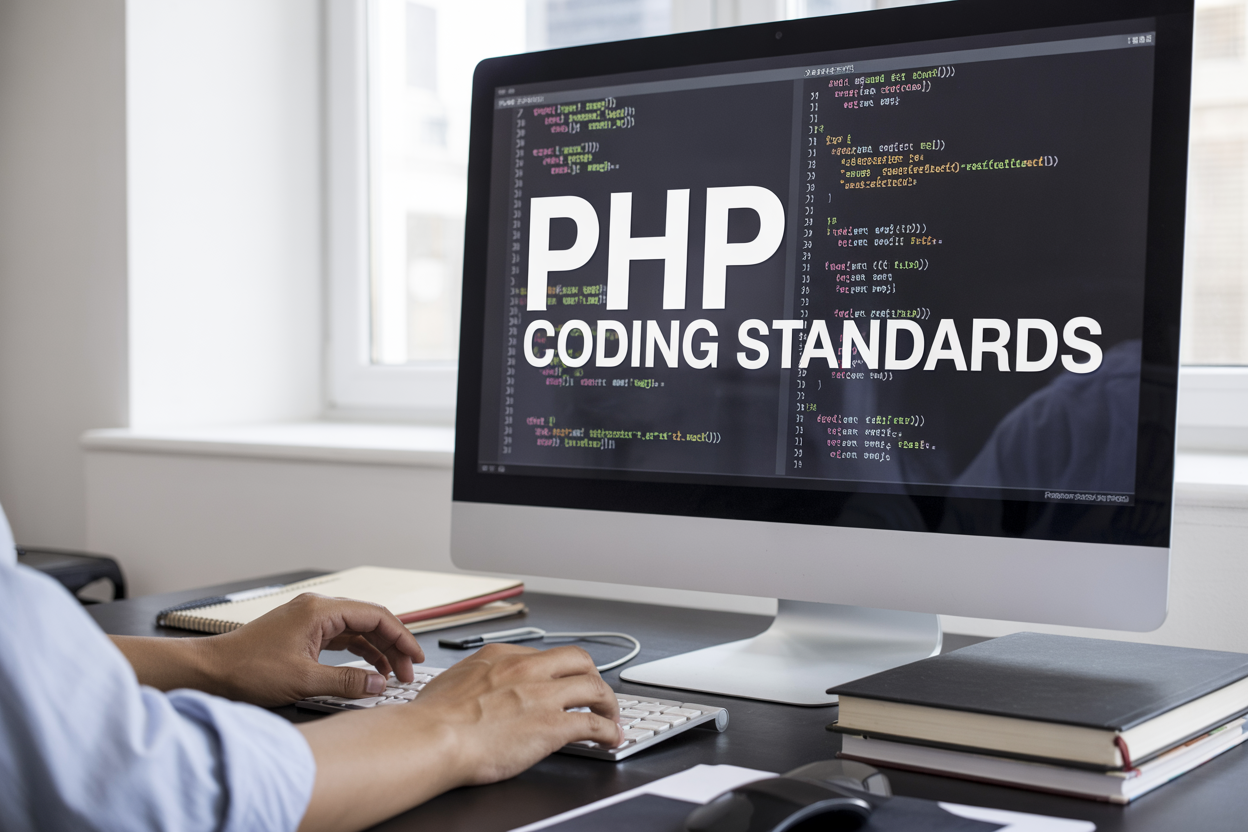Clean, readable code separates good PHP developers from great ones. PHP naming conventions and coding standards help your team write code that’s easy to understand, maintain, and debug—whether you’re building your first web application or managing enterprise-level projects.
This guide covers the essential PHP coding standards every developer should know. You’ll learn proven variable naming PHP techniques that make your code self-documenting, plus function naming conventions PHP that clearly communicate what your methods do. We’ll also walk through class naming standards PHP that follow industry best practices and explore PHP code formatting rules that keep your entire team on the same page.
Following PHP PSR standards and clean code PHP principles isn’t just about looking professional—it’s about writing code that works better and breaks less often. These PHP development guidelines will help you create more maintainable applications and collaborate more effectively with other developers.
Variable Naming Conventions That Improve Code Readability

Use descriptive camelCase for better understanding
CamelCase naming stands as the gold standard for PHP variable naming conventions. This approach capitalizes the first letter of each word except the first one, creating variables like $userName, $orderTotal, or $customerEmailAddress. The beauty of camelCase lies in its readability – your brain naturally separates each word, making code significantly easier to scan and understand.
When implementing camelCase in PHP development guidelines, start with a lowercase letter and capitalize subsequent words. Variables such as $isLoggedIn, $maxRetryCount, or $databaseConnectionString immediately communicate their purpose to anyone reading your code. This PHP naming convention eliminates the guesswork that comes with cryptic variable names.
Apply consistent prefixes for different data types
Type prefixes help developers quickly identify what kind of data they’re working with, especially in larger codebases. Boolean variables benefit from prefixes like is, has, can, or should. Examples include $isActive, $hasPermission, $canEdit, or $shouldCache. These PHP best practices make conditional statements more readable and self-documenting.
For arrays, consider prefixes like $listUsers or $arrayProducts. Object instances work well with descriptive names like $userModel or $paymentProcessor. String variables might use prefixes such as $strMessage or simply descriptive names like $errorMessage. Consistent prefixing across your team creates a shared language that speeds up code reviews and debugging sessions.
Avoid abbreviations that confuse team members
Abbreviations might save a few keystrokes, but they create confusion and technical debt. Variables like $usr, $pwd, $tmp, or $cfg force developers to decode meaning every time they encounter them. Instead, spell out complete words: $user, $password, $temporary, $configuration. Your future self and teammates will thank you.
Common abbreviations that should be avoided include $num (use $number), $calc (use $calculator), $mgr (use $manager), and $proc (use $processor). Clean code PHP principles emphasize clarity over brevity. Modern IDEs provide autocomplete features that make typing longer names effortless.
Choose meaningful names over short cryptic ones
Meaningful variable names serve as inline documentation. Instead of $x or $data, use names that explain the variable’s role: $monthlyRevenue, $validatedUserInput, or $filteredSearchResults. This approach follows PHP PSR standards and makes your code self-explanatory.
Single-letter variables have their place in short loops ($i, $j, $k) but should never represent business logic or complex data structures. Variables like $a, $b, $temp, or $stuff provide zero context about their contents or purpose. Professional PHP development requires names that communicate intent clearly, reducing the need for comments and making code maintenance significantly easier.
Function and Method Naming Best Practices

Start with action verbs for clear purpose indication
Action verbs make function and method names instantly understandable by telling readers exactly what the code does. Instead of naming a function userData(), use getUserData() to clearly show it retrieves user information. This PHP naming convention creates self-documenting code that reduces the need for comments and makes debugging easier.
Common action verbs in PHP development include:
- get for retrieving data:
getCustomerDetails(),getCurrentUser() - set for assigning values:
setPassword(),setDefaultTheme() - create or make for generating new objects:
createSession(),makeConnection() - update for modifying existing data:
updateProfile(),updateInventory() - delete or remove for elimination operations:
deleteRecord(),removeExpiredTokens() - validate for checking data:
validateEmail(),validateFormInput() - process for handling operations:
processPayment(),processImageUpload()
Boolean-returning functions benefit from question-style verbs like is, has, can, or should. Examples include isLoggedIn(), hasPermission(), canEdit(), and shouldRetry(). This approach immediately signals that the function returns true or false, making conditional statements more readable.
Keep names concise yet descriptive
Balancing brevity with clarity requires thoughtful consideration of each function’s purpose. While calculateMonthlyInterestRateForLoanApplication() describes exactly what happens, calculateLoanInterest() provides enough context without overwhelming the reader. The key lies in including essential information while removing redundant words.
Avoid unnecessary words that don’t add meaning:
- Remove articles:
getTheUser()becomesgetUser() - Skip obvious context:
userGetAge()becomesgetAge()when inside a User class - Eliminate redundant prefixes:
dataValidateInput()becomesvalidateInput()
Context matters significantly in PHP naming conventions. A method called save() inside a DatabaseConnection class clearly handles database operations, while the same name in a FileManager class suggests file operations. Class context eliminates the need for prefixes like dbSave() or fileSave().
Consider abbreviations carefully. Common abbreviations like id, url, html, and json are widely understood, but avoid obscure shortcuts that might confuse other developers. getUsrInf() saves characters but sacrifices clarity compared to getUserInfo().
Follow consistent naming patterns across projects
Consistency creates predictable code patterns that speed up development and reduce mental overhead. When team members know that all data retrieval functions start with get and all validation functions start with validate, they can navigate codebases faster and write new functions that fit established patterns.
Establish project-wide conventions for common operations:
- CRUD operations:
create,read/get,update,delete - API interactions:
fetch,post,put,patch - File operations:
load,save,export,import - Authentication:
login,logout,authenticate,authorize
Document these patterns in your team’s PHP coding standards guide. Include examples showing preferred naming styles for different scenarios. This documentation becomes especially valuable when onboarding new team members or revisiting older projects.
Version control commits reveal naming inconsistencies across projects. Regular code reviews should check for pattern adherence, ensuring that getUserById() in one project doesn’t become fetchUserWithId() in another. Tools like PHP CodeSniffer can enforce naming rules automatically, catching deviations before they reach production.
Cross-project consistency also applies to parameter naming. If one function uses $userId as a parameter, maintain this convention rather than switching to $user_id or $id in similar functions. This attention to detail creates professional, maintainable codebases that reflect PHP best practices.
Class and Interface Naming Standards

Use PascalCase for Professional Appearance
PascalCase serves as the gold standard for PHP class and interface naming conventions. This approach capitalizes the first letter of each word without spaces or underscores, creating clean and professional-looking code that aligns with PHP PSR standards.
class UserAuthentication
class DatabaseConnection
interface PaymentProcessorInterface
The visual consistency PascalCase provides makes your codebase instantly recognizable to other developers. When team members see OrderManagement or ProductCatalog, they immediately understand these represent classes or interfaces rather than variables or functions.
Choose Names That Reflect Actual Functionality
Effective class naming in PHP requires precision and clarity about what your code actually does. Your class names should act like mini-documentation, telling other developers exactly what behavior to expect.
Consider these examples:
// Clear and functional
class EmailValidator
class ShoppingCart
class DatabaseMigrator
// Vague and unhelpful
class Helper
class Manager
class Handler
When naming classes, focus on the primary responsibility. A class that validates user input should be UserInputValidator, not just Validator. This specificity prevents confusion and makes your PHP development guidelines more maintainable.
Apply Descriptive Suffixes for Interfaces
PHP best practices recommend using clear suffixes to distinguish interfaces from concrete classes. The most common approach adds “Interface” as a suffix, though other descriptive endings work well too.
interface PaymentInterface
interface LoggerInterface
interface CacheInterface
// Alternative approaches
interface Cacheable
interface Serializable
interface Comparable
This naming strategy helps developers quickly identify contracts versus implementations. When you see DatabaseInterface alongside MySqlDatabase and PostgresDatabase, the relationship becomes immediately clear.
Avoid Generic Names That Provide No Context
Generic class names create confusion and make code harder to maintain. Names like Data, Info, Utils, or Common tell developers nothing about the actual purpose or functionality.
Instead of generic approaches:
// Avoid these generic names
class Data
class Utils
class Common
class Base
// Use specific, meaningful alternatives
class CustomerData
class StringUtils
class ApplicationConfig
class AbstractValidator
Specific names make your PHP naming conventions more effective and reduce the mental overhead required to understand your codebase. Every class name should answer the question “what does this do?” without forcing developers to dive into implementation details.
File and Directory Organization Rules

Match file names with class names exactly
Your PHP file names should mirror your class names perfectly. When you create a class called UserRepository, the file should be named UserRepository.php – not userrepository.php, user_repository.php, or any other variation. This practice follows PSR-4 standards and makes your codebase predictable.
The case sensitivity matters here. PHP class names are case-sensitive, and maintaining this consistency prevents confusing errors when your code runs on different operating systems. Linux servers treat UserRepository.php and userrepository.php as completely different files, while Windows might not care about the case difference.
Best practices for file-class matching:
- Use PascalCase for both class names and file names
- Include only one class per file
- Keep namespace structure aligned with directory structure
- Avoid abbreviations or shortened versions of class names
Use lowercase with hyphens for directories
Directory names should use lowercase letters with hyphens to separate words. This approach creates readable URLs when your directories become part of web paths and maintains consistency across different environments.
Instead of naming directories like UserManagement or user_management, use user-management. This convention works well with web servers and creates clean, SEO-friendly URLs if these directories serve web content.
Directory naming guidelines:
- Always use lowercase letters
- Separate multiple words with hyphens
- Keep names descriptive but concise
- Avoid special characters except hyphens
- Use plural forms for directories containing multiple similar items
Group related files in logical folder structures
Organizing your PHP files into logical folder structures makes your codebase easier to navigate and maintain. Group files by their function, feature, or architectural layer rather than by file type alone.
Create directories that represent business domains or application layers. For example, group all user-related classes in a user directory, including User.php, UserController.php, UserRepository.php, and UserService.php. This approach beats scattering these files across separate models, controllers, and repositories directories.
Effective folder organization patterns:
- Feature-based grouping:
user/,product/,order/ - Layer-based grouping:
controllers/,models/,services/ - Hybrid approach combining both strategies
- Configuration files in dedicated
config/directory - Third-party libraries in
vendor/(via Composer)
Consider your project’s growth when designing folder structures. Small projects might work fine with simple groupings, but larger applications benefit from deeper hierarchies. The key lies in making file locations predictable – any developer should guess where to find a specific class based on its purpose and your established patterns.
Code Formatting Guidelines for Team Consistency

Set proper indentation standards
Consistent indentation forms the backbone of readable PHP code. Most PHP development teams adopt either 4 spaces or tabs for each indentation level, with 4 spaces being the preferred choice according to PSR standards. This approach creates visual hierarchy that makes code structure immediately apparent to anyone reviewing your work.
When writing nested code blocks like loops within conditionals, each level should receive exactly one indentation increment. This prevents the common mistake of inconsistent spacing that makes code look messy and hard to follow. Modern IDEs can automatically handle indentation, but setting up your editor’s preferences correctly saves hours of manual formatting later.
Teams should document their indentation choice in coding guidelines and configure their development environment accordingly. This prevents the frustrating tab-versus-space debates that can derail productivity.
Apply consistent spacing around operators
Proper spacing around operators dramatically improves code scanning speed. Place single spaces before and after assignment operators, comparison operators, and arithmetic operators. For example, $result = $value + 10 reads much better than $result=$value+10.
Concatenation operators deserve special attention in PHP. The dot operator should have spaces on both sides: $message = 'Hello ' . $name . '!'. This spacing rule applies to compound operators too, like +=, -=, and .=.
Array arrows require consistent spacing as well. Write $array = ['key' => 'value'] rather than cramming everything together. These small spacing choices add up to create code that feels professional and polished.
Use line breaks strategically for readability
Strategic line breaks transform dense code blocks into digestible sections. Break long function calls across multiple lines when they exceed 80-120 characters, placing each parameter on its own line with proper indentation.
Method chaining benefits from vertical alignment where each chained method starts on a new line. This approach makes debugging easier since you can quickly identify which method in the chain might be causing issues.
Logical groupings within functions should be separated by blank lines. Group variable declarations together, separate business logic sections, and isolate return statements. This creates natural reading rhythm that helps developers understand code flow quickly.
Follow bracket placement conventions
Bracket placement might seem trivial, but consistent style prevents cognitive friction when switching between different parts of your codebase. The opening curly brace for classes, functions, and methods should appear on the next line, while control structures like if statements and loops place the opening brace on the same line.
class UserManager
{
public function createUser($data)
{
if ($this->validateData($data)) {
// Process user creation
}
}
}
This PSR-compliant approach provides visual consistency that makes code structure immediately recognizable. Closing braces should align with the statement that opened the block, creating clear visual boundaries.
Maintain uniform comment formatting styles
Comment formatting standards prevent documentation from becoming an afterthought. Use DocBlock format for all class and method comments, including parameter types, return values, and brief descriptions. Single-line comments should use // syntax with a space after the slashes.
Inline comments need careful placement – position them above the code they explain rather than at the end of lines. This prevents horizontal scrolling and keeps explanations clearly associated with their relevant code sections.
Block comments work well for explaining complex algorithms or business logic. Format them consistently with proper spacing and alignment to maintain the professional appearance of your PHP codebase.

Clean, consistent naming and coding standards make all the difference between code that’s a pleasure to work with and code that makes you want to pull your hair out. When your variables clearly describe what they hold, your functions tell you exactly what they do, and your classes follow predictable patterns, debugging becomes easier and new team members can jump in without getting lost. These standards aren’t just about making your code look pretty – they’re about creating a shared language that everyone on your team can understand.
Start implementing these practices gradually if you haven’t already. Pick one area, like variable naming, and focus on getting that right before moving to the next. Your future self will thank you when you’re revisiting code you wrote months ago, and your teammates will appreciate not having to decode cryptic function names or hunt through messy file structures. Good coding standards are an investment that pays dividends every single day.




















